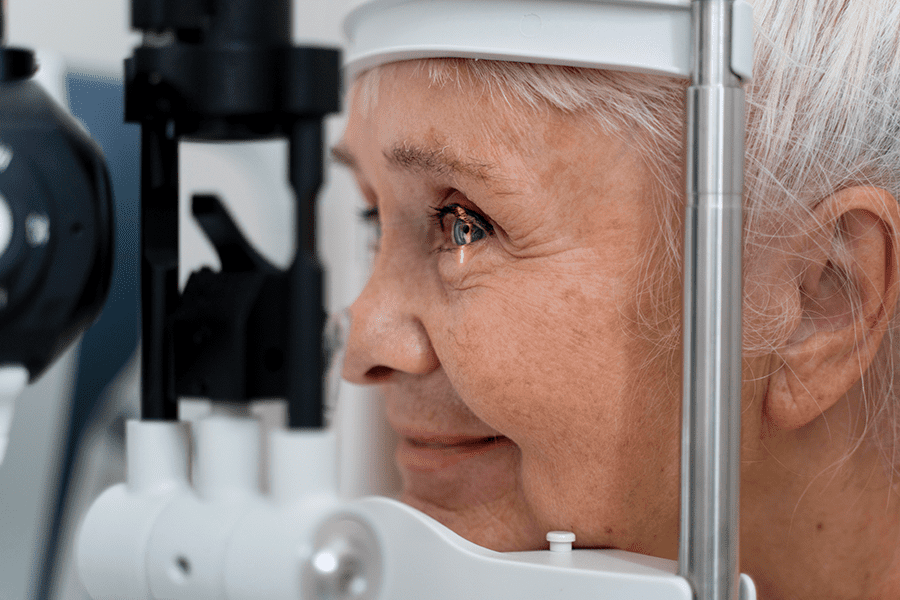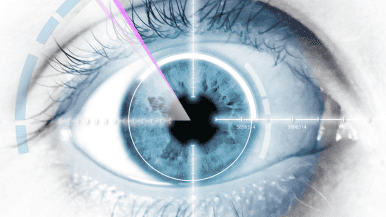- What is a cataract?
- What are the symptoms of a cataract?
- What does a cataract look like?
- How are cataracts treated?
The main problem with cataracts is that you may not even realize you have them until they start to damage your eyes. That’s because the early stages of this disease have very few symptoms, and it’s also hard to detect them from the outside at first. When does a change in your vision become noticeable and what does a cataract look like?
At Ocala Eye, we have answers about the very common condition called a cataract and what happens when you start to develop one.
What Is a Cataract?
 In healthy eyes, the lens at the front of the eye is clear, allowing light to pass through without any barrier. However, as you age or if the eye has been injured, this clear lens can grow cloudy and filmy. That film is caused by the breakdown of proteins in the lens. Eventually, this protein buildup covers the clear window that you see through.
In healthy eyes, the lens at the front of the eye is clear, allowing light to pass through without any barrier. However, as you age or if the eye has been injured, this clear lens can grow cloudy and filmy. That film is caused by the breakdown of proteins in the lens. Eventually, this protein buildup covers the clear window that you see through.
This is the process of a cataract forming and, if not treated, it can impair or even cause you to go blind over time. There are three primary types of cataracts:
- Cortical
- Nuclear sclerotic
- Posterior subcapsular
Cortical cataracts form on the eye lens in a kind of a wagon wheel shape. Fissures form the spokes of the wheel, causing the light to enter the eye in a scattered, disorganized way. This creates problems with contrast and depth perception.
Nuclear sclerotic cataracts are the most common, starting with a slow hardening of the central part of the lens nucleus. Over time, this hardening process extends across the lens. This type of cataract is particularly interesting because your ability to see things close up (such as for reading) may temporarily improve. Unfortunately, that doesn’t last as the cataract grows and your vision declines.
Posterior subcapsular cataracts strongly affect your night vision and ability to read. This type of cataract actually begins to form beneath the lens capsule, which is a small membrane that helps hold the lens in place.
No matter which type affects you, cataracts are the leading cause of vision impairment in the U.S. This condition particularly affects seniors. Today, 24.5 million people have cataracts in the United States and that number will double in less than 30 years.
What Are the Symptoms of a Cataract?
As the cataract begins to form you may have no symptoms. That’s why it’s so important to have your eyes checked every year by your ophthalmologist. When you begin to notice the effects of the cataracts, you will likely experience:
- Cloudy spots in your field of vision that start out small and grow over time
- Color changes where the hues around you begin to dim and yellow
- Double vision in one or both eyes
- Halos around lights and glare in your field of vision, particularly noticeable at night
- Light sensitivity that makes it hard to withstand bright sun or even indoor lights
- Problems with your night vision, in particular your ability to drive will be affected by the cataracts


The irony of cataract growth is that at first you simply won’t notice a problem. That’s the best time for your ophthalmologist to catch the disease in its early stages. Small cataracts don’t necessarily grow quickly, so you can consult with your doctor about a treatment plan which may slow down the progression of the disease. For example, you could:
- Ask about the side effects of any medications you’re on to be sure it doesn’t speed up the cataract growth
- Change your diet and add more omega-3 fatty acids
- Increase your eyeglass prescription so you can see better for as long as possible
- Quit smoking
- Wear a wide-brimmed hat and sunglasses outside
Over time, as the cataracts worsen, your friends and family may begin to see the physical symptoms of the cataracts in your eyes. What will they see? What does a cataract look like?
What Does a Cataract Look Like?
 If you have a cataract, you may not notice anything wrong at first with your eye when you look in the mirror. As the years progress with the disease, you’ll start to notice a cloud of white beginning to cover the pupil of your eye, obscuring the color.
If you have a cataract, you may not notice anything wrong at first with your eye when you look in the mirror. As the years progress with the disease, you’ll start to notice a cloud of white beginning to cover the pupil of your eye, obscuring the color.
The American Academy of Ophthalmology has a very informative page with pictures of the different types of cataracts. In these pictures, you can clearly see how the cataracts look as they grow and worsen.
Cataracts can progress so they cover the entire colored portion of the eye with a bluish opaque circle. If you have uncontrolled diabetes, the sugar in your bloodstream can change the lens of the eye, causing a cataract that looks a bit like a snowflake. This gray-white cataract can worsen until blindness occurs.
What Causes Cataracts?
The natural progression of aging can cause cataracts. There are also lifestyle or other health factors that could lead to cataracts. This includes:
- Being in the sun without UV sunglasses
- Diabetes
- Eye injury
- Excessively and chronically drinking alcohol
- Genetic disorders
- Long-term use of steroids
- Smoking
You can lessen the chances of developing cataracts later in life by taking care of your health in several ways. For example, if you are smoking, try to quit or cut back. If you play sports, always wear protective eye gear to protect yourself from a traumatic eye injury.
How Are Cataracts Treated?
The best treatment for cataracts is surgery to remove the clear lens at the front of the eye. This outpatient procedure carefully removes the damaged lens and replaces it with an artificial lens. It’s an effective, safe way to bring back the vision you’ve lost from cataracts.
If you’re having the symptoms of cataracts or if you haven’t scheduled your annual exam, please contact us online or over the phone. Our Ocala Eye cataract surgeons will work with you to protect your vision.




